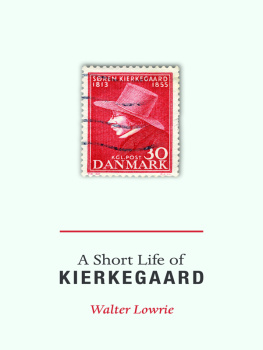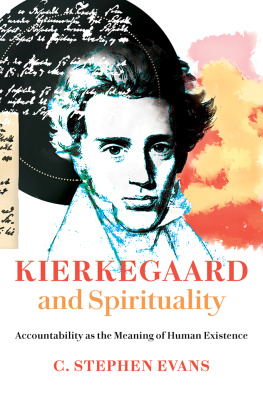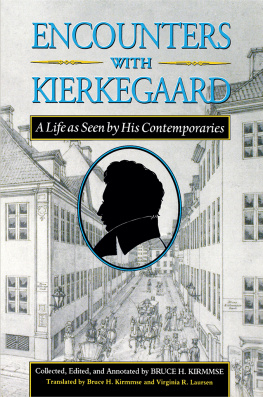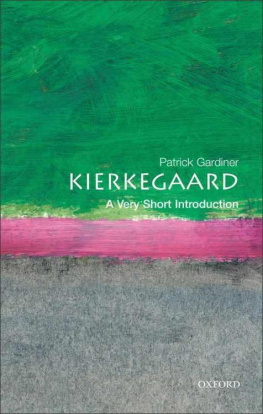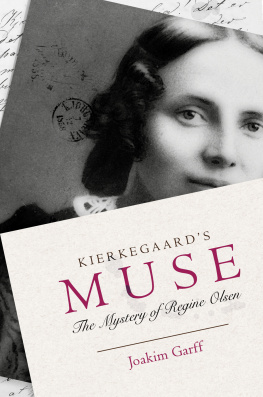
A Short Life of Kierkegaard
A SHORT LIFE OF Kierkegaard
BY
WALTER LOWRIE

With Lowries essay How Kierkegaard Got into English and a new introduction by Alastair Hannay
PRINCETON UNIVERSITY PRESS
PRINCETON AND OXFORD
A Short Life of Kierkegaard copyright 1942, 1970
by Princeton University Press
How Kierkegaard Got into English copyright 1941
by Princeton University Press
Introduction by Alastair Hannay copyright 2013
by Princeton University Press
Published by Princeton University Press, 41 William Street, Princeton, New Jersey 08540
In the United Kingdom: Princeton University Press, 6 Oxford Street, Woodstock, Oxfordshire OX20 1TW
press.princeton.edu
All Rights Reserved
First printing of A Short Life of Kierkegaard, 1942
Fifth paperback printing, 1974
Paperback reissue, with How Kierkegaard Got into English and an introduction by Alastair Hannay, 2013
Library of Congress Control Number 2012952482
ISBN 978-0-691-15777-1
British Library Cataloging-in-Publication Data is available
Printed on acid-free paper.
Printed in the United States of America
1 3 5 7 9 10 8 6 4 2
TO
JOHN A. MACKAY
DOCTOR OF THEOLOGY PRESIDENT OF PRINCETON THEOLOGICAL SEMINARY AT HOME ON BOTH AMERICAN CONTINENTS AND BEFORE BECOMING AMERICAN A KIERKEGAARDIAN THIS LITTLE BOOK IS AFFECTIONATELY DEDICATED
CONTENTS
INTRODUCTION
WALTER LOWRIE was ninety-one years old when he died at Princeton Hospital on August 12, 1959, the recent translator of twelve works of Kierkegaard, author of this Short Life and of its more than six-hundred-page predecessor. Although Lowries engagement with Kierkegaard had begun earlier in the century, it is staggering to realize that it was not until he had reached the age of sixty-four that he began studying Danish with a view to translation. The energy and enthusiasm with which he plunged into this enormously influential undertaking is still tangible in the retrospective essay accompanying this reissue of the Short Life. The reissue itself, apart from providing a welcome opportunity to renew our appreciation of Lowrie, also offers a chance to look at the motivation behind such prodigious effort and at its effect on the ways in which the English-speaking world has taken, or not taken, to Kierkegaard.
For a present generation of scholars young enough to have been directed to the sometimes forbidding, fearsomely annotated, but formidably established Hong translations, the fact that the Danish thinkers name was hardly known in Anglophone circles in the 1940s may be hard to believe. For my own generation it was through the eminently readable renderings by Alexander Dru, David F. Swenson, and Walter Lowrie that we first met Kierkegaard, so to speak, face to face. As with many others still today, my first contact was with Fear and Trembling, the book Kierkegaard believed would make him famous. Although Lowrie modestly describes his translations as more literal than literary, I think most readers will agree that the latter is largely false, while on the other hand many will have discovered that the former is not always true. To me, with its iconic narrative and the stark alternatives drawn from it, Fear and Trembling came through loud and clear, the louder and clearer for not being read through a now ever-thickening prism of textual commentary and explanation. From that provocative beginning it was natural to proceed to the invitingly entitled Either/Or, a translation left unfinished by David Swenson and completed by Lowrie. Still energized, I proceeded, though at times flaggingly, through the outwardly ramshackle and seemingly endlessly concluding Postscript, this being Lowries completion of yet another unfinished Swenson translation. That work, Concluding Unscientific Postscript: A Mimic-Pathetic-Dialectic Composition, An Existential Contribution, had already appeared in 1941, and by this time the firm Swenson and Lowrie had all but become synonymous with at least the first part of its long title. Packing in, as it does, most of Kierkegaards thought up to the time it was written, Swenson and Lowries Postscript became the Anglophone Kierkegaard scholars bible, just as Lowries Kierkegaard from 1938 was the original source of all those iconic anecdotes that were the stock-in-trade of the Kierkegaard cognoscenti: the strict father who as a child had cursed God, the rebellious young man, the broken engagement, the spat with The Corsair., the all-out attack on the church, the terminal sickness when his money had just run out.
There are by now several English-language biographies of Kierkegaard. None, however, shows the near devotional respect for its subject that we find in Lowries Kierkegaard. Nor does A Short Life contain any noticeable revision in this respect, its brevity made possible, as Lowrie explains in the essay, because there was no longer a necessity for such abundant quotation. In what is generally taken to be an antidote to Lowries glowing portrayal, Josiah Thompson has portrayed Kierkegaard, with considerable scenic skill, as a somewhat elusive anti-hero.
Walter Lowries biographies are sometimes described as hagiography. What truth there is in this can be left to his readers. But it is as well to sketch in those features of Lowries own life that would lead one to expect a fairly saintly portrait from his hand. If there has been a tendency in some quarters, and particularly in the United States, to canonize Kierkegaard, something that a fair knowledge of what Kierkegaard wrote about himself tells us is misguided, then some of the blame must indeed be placed on Lowrie. Not that saintliness is out of the question; it is well known that Ludwig Wittgenstein found some. But the latters background and atheistic leanings lead one to suppose that he saw it in some quality other than the staunch upholding of Christian faith. In a Faroese novel (translated as The Lost Musicians) Kierkegaard is described as the tragic satan, one who, by attacking reason with its own weapons and then turning them mercilessly on himself, upstages even Mephistopheles.In general, we should probably accept as a twofold truth that Kierkegaard was a complex person as well as a complex writer, and that a biography cannot help but be to some extent a reflection of the biographers own background. When a good portrait painter chooses the sitter for the portrait he or she is about to paint, the attraction that led to that choice is almost certain to be visible in the result.
Lowrie, and we might well call him a man of his time, could have overlapped Kierkegaard had not the latter died an early death at forty-two just thirteen years before Lowrie was born on April 26, 1868, the son of a clergyman. He attended Lawrenceville School in New Jersey and then, in the fall of 1886, entered the freshman class at Princeton College. On graduating in 1890 he continued to Princeton Theological Seminary, taking a masters degree in divinity in 1893. Between then and 1899, between assorted clerical positions including several years as summer minister in New York State, Lowrie spent three periods of study abroad, which took him to Germany, Switzerland, and Italy. Rome was on the last two itineraries, and it was there, after further study at Princeton and some pastoral work elsewhere, that he was to settle for twenty-three years as rector of St. Pauls American Church in Rome. Appointed in 1907 at the age of thirty-nine, he remained in that post until he was sixty-two, at which point having lived, off and on, for twenty-seven years on the Continent of Europe, he returned home, in his own words, as a superannuated clergyman.
Next page
